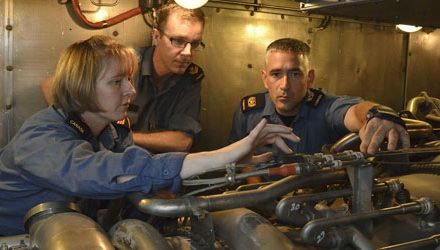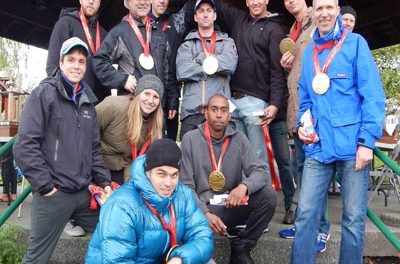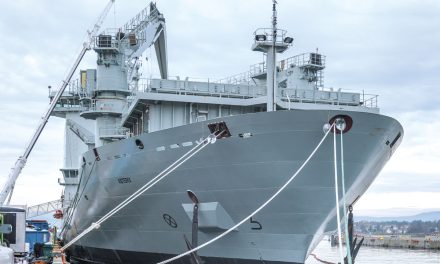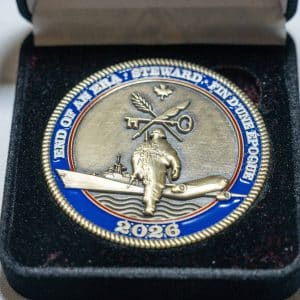
A new organization, Director General Future Ship Capability, will help ensure future ships such as the Arctic Offshore Patrol Vessel will be introduced smoothly into service.
Darlene Blakeley, Navy Public Affairs Ottawa ~
A new organization designed to support the Royal Canadian Navy (RCN) as it receives new ships for future operations, aims to introduce them into service smoothly, and with a view to driving naval innovation.
Director General Future Ship Capability (DGFSC), headed by Rear-Admiral Casper Donovan, will ensure the RCN is ready in terms of occupations, training systems, infrastructure, doctrine and tactics, and operational policies as ships are completed and turned over to the navy.
DGFSC has three main components.
The first is the Directorate of Naval Major Crown Projects, which includes the RCN teams assigned to the new Arctic and Offshore Patrol Ship (AOPS), Joint Support Ship (JSS) and Canadian Surface Combatant (CSC) projects.
The second is the Directorate of New Capability Introduction (DNCI), which includes a team in Ottawa, as well as detachments in Halifax, NS, and Esquimalt, BC.
The third is the Maritime Innovation Team (MIT).
“DNCI is critical to ensuring the RCN is ready, in all respects, to receive new ships and is ready to introduce them into operational service,” explains RAdm Donovan. “They are focused on all things other than the ship itself, such as crewing, training, infrastructure, helicopter integration, occupational structures, tactics development and readiness standards.”
MIT is a small team which works within DGFSC to ensure the RCN innovates as it introduces the future fleet.
“It’s not just about new ships, it’s also about new approaches to how the navy will deliver on its future missions,” RAdm Donovan says. “This mindset requires innovation to be at the forefront of everything we do.”
He adds that DGFSC is well set up to enable this innovation.
“Obviously the inclusion of MIT in the organization helps, but I would also say that marrying the three project teams with the DNCI organization creates great synergy between what we are pursuing with each project and the folks who are embedded on the coasts. These DNCI personnel are plugged into the broader RCN organization so that we all stay in sync as to where we are going in key functional areas, like our future naval training system or in pursuing a much more digital navy.”
RAdm Donovan says the new organization affords the navy a more dedicated capacity to devote to all future ship builds, but particularly the CSC.
“The CSC is undoubtedly the main effort for DGFSC, but not the exclusive focus. The RCN has much to learn from both the AOPS and JSS projects, like we did from the Halifax Class Modernization project, that will shape, influence and inform what we potentially do with the CSC. It makes a lot of sense to have all the ship projects in DGFSC.”
This dedicated capacity is especially important once the design for the CSC has been selected.
“There will be a significant amount of work which the project team will need to begin and progress in an expedient manner,” RAdm Donovan says. “There is no time to waste – all the organizations involved with the CSC want to complete the design and start cutting steel as quickly as is reasonably possible.”
There are three main things he’d like to accomplish during his tenure as DGFSC. First, he’d like to see Harry DeWolf, the first Arctic and Offshore Patrol Vessel, introduced into service smoothly.
“Once the ship is ready to be transitioned from the shipyard to the navy, we will have thought through all the details, so it is very seamlessly introduced into operational service on behalf of Canada and Canadians. There is so much work behind-the-scenes that we can’t lose sight of, and Harry DeWolf will be the first test of how we do. There will be 21 to 22 more ships to introduce as we move into the future.”
Second, he wants to establish the RCN Innovation Program and move forward with momentum. This includes encouraging a culture of innovation in the RCN, laying out priority areas and initiatives where innovation is pursued, and seeing these initiatives materialize in the fleet and ashore.
Finally, he’d like to see the CSC enter its design phase as early as possible in 2019.
“There’s a ton of work to do prior to entering the design phase, but if we put our minds towards doing this work in a smart and disciplined manner, we can accomplish a lot in a short time.”
DGFSC, in conjunction with Commodore Rich Feltham’s team at the Director General Naval Force Development (DGNFD), “double-downs” on the future needs of the navy and the goals of the defence policy Strong, Secure, Engaged.
“We are bolstering the navy’s capacity to move on Strong, Secure, Engaged by more capably covering off the major ship builds and innovation. This overall team approach between DGFSC and DGNFD is key to our success,” says RAdm Donovan. “Pulling it all together coherently will be challenging, but the team is up to the task.”









